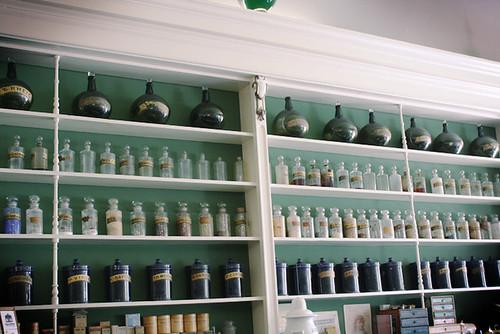Designing Your Workspace
When designing your workspace, one of the first things to consider is air quality. Essential oils and aroma chemicals are, of course, smelly! Good ventilation and odor containment are important considerations when setting up your lab. For your own health, and also for your ability to detect differences between scents, you need to keep the fragrant “noise” to a minimum. Some options to consider:
- Install an exhaust fan (like the kind you find in bathroom ventilation).
- Manage the trash. Use a can with a lid that seals.
- Store raw materials in cabinets with doors that shut (glass or plastic doors allow view of bottles).
- When testing perfumes on scent strips, consider using a bell jar, or a homemade one out of plastic bottle.
- Wear disposable latex gloves to avoid contaminating your fingers.
Your “bench” or worktable may be subject to aroma chemical spills from time to time, so choose a non-reactive, non-absorbent surface that’s easy to clean. Some options:
- Stainless Steel – food prep tables from restaurant supply companies work well, for example.
- Formica
- Glass top – tempered is best.
Refrigeration. Some aroma chemicals, like the citruses, will have a longer shelf life when refrigerated. Consider getting a mini fridge or a wine fridge.
Lab Equipment List
Lab Notebook – Always take notes. Take notes when smelling and familiarizing yourself with a new chemical. Take notes as you formulate a new blend. Note what works, note what doesn’t. Note everything.
Digital Scale accurate to 0.01g – Perfume industry professionals measure raw materials by weight. Ohaus makes a pricy but nice scale. And there are less expensive options, too. Several good people on Basenotes recommend this one from Old Will Knot that seems to have all the right features at a good price.
Tiny Glass Beakers – If you are working by volume (many recipes are in drops/ml), you’ll want to be able to measure accurately in ml. Look for beakers with small graduations (10, 15, 30 ml). You can find these at lab supply companies or nifty vintage beakers on eBay. These 25 ml graduated beakers at Aqua Oleum in the UK are some of the most ideal beakers I’ve seen, and very reasonably priced.
Pipettes or droppers
- Glass droppers (if you plan to reuse your droppers, you must rinse them in alcohol so you won’t cross-contaminate).
- Calibrated glass droppers are especially useful.
- Disposable plastic pipettes like these, or also these.
Tiny funnels. You can also get them in glass.
And maybe something like this to hold all those test strips, or like this. Or possibly this. I’ve also heard you can use chopstick rests.
Casseroles – for melting small quantities of beeswax if you are making solid perfumes.
Curettes for scooping out viscous and resinous absolutes like vanilla, benzoin, and fir. You can find them in bamboo or stainless steel.
Hot Plate
If making solid perfumes, you will need a heat source. You can work over your kitchen stove with a double-boiler – or if you’d prefer not to work in your kitchen, you can get a hot plate as an alternative heat source. There are a range of options.

